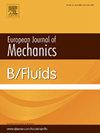An experimental study on the transition of electrohydrodynamic spraying process and regime
IF 2.5
3区 工程技术
Q2 MECHANICS
引用次数: 0
Abstract
Electrohydrodynamic (EHD) spraying based manufacturing techniques are remarkably useful for the fabrication of micro/nanoscopic multi-functional devices but also quite complicated owing to their highly changeable spraying behavior and regime. For the propose of gaining more knowledge about different EHD spraying process and regime, this paper carries out an experimental study on EHD spraying of ethanol under a wide range of three key operating parameters: applied voltage ( = 1500– 4000 V), flow rate ( = 0.05, 0.1, 0.2, 0.3 mL/min), and nozzle height ( = 5, 10, 20, 30 mm), while nozzle height was a variable that was barely investigated in previous EHD spraying studies. Six distinct spraying regimes, namely Dripping, Spindle, Atomization, Spindle + Atomization, Whipping, and Oscillation are discovered, whose dependences on these three parameters are demonstrated and explained. Besides, as a significant part of the EHD spraying process, the variations of the spraying period and morphology with these three parameters are also discussed. Moreover, the variations of the spraying regime, spraying frequency, and nondimensionalized Taylor cone length with the electric Bond number and dimensionless flow rate are analyzed, which signifies the close correlation between these dimensionless variables and liquid spraying behaviors. The findings in this work can be used for promoting the understanding of EHD spraying process and achieving more accurate regulation of EHD spraying based manufacturing techniques.
电液动力喷涂过程与状态过渡的实验研究
基于电流体动力学(EHD)喷涂的制造技术在微/纳米多功能器件的制造中非常有用,但由于其高度多变的喷涂行为和状态而相当复杂。为了更好地了解不同的EHD喷涂工艺和制度,本文对乙醇的EHD喷涂进行了大范围的三个关键操作参数的实验研究:施加电压(Φ = 1500 - 4000 V)、流速(Q = 0.05、0.1、0.2、0.3 mL/min)和喷嘴高度(H = 5、10、20、30 mm),而喷嘴高度是以往EHD喷涂研究中很少研究的一个变量。发现了六种不同的喷涂方式,即滴淋、主轴、雾化、主轴+雾化、搅拌和振荡,并演示和解释了这三个参数的依赖关系。此外,作为EHD喷涂过程的重要组成部分,本文还讨论了这三个参数对喷涂周期和形貌的影响。分析了喷淋方式、喷淋频率和无量纲泰勒锥长度随电键数和无量纲流量的变化规律,表明这些无量纲变量与液体喷淋行为密切相关。本研究结果可用于促进对EHD喷涂工艺的理解,并实现更精确的EHD喷涂制造技术的调控。
本文章由计算机程序翻译,如有差异,请以英文原文为准。
求助全文
约1分钟内获得全文
求助全文
来源期刊
CiteScore
5.90
自引率
3.80%
发文量
127
审稿时长
58 days
期刊介绍:
The European Journal of Mechanics - B/Fluids publishes papers in all fields of fluid mechanics. Although investigations in well-established areas are within the scope of the journal, recent developments and innovative ideas are particularly welcome. Theoretical, computational and experimental papers are equally welcome. Mathematical methods, be they deterministic or stochastic, analytical or numerical, will be accepted provided they serve to clarify some identifiable problems in fluid mechanics, and provided the significance of results is explained. Similarly, experimental papers must add physical insight in to the understanding of fluid mechanics.

 求助内容:
求助内容: 应助结果提醒方式:
应助结果提醒方式:


